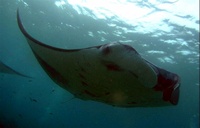
The manta ray, or giant manta (Manta birostris), is the largest of the rays, with the largest known specimen having been nearly 7.6 meters (25 ft) across its pectoral fins (or "wings") and weighed in at 3,000 kg (6,600 lb). It ranges throughout the tropical seas of the world, typically around coral reefs. Mantas are most commonly black above and white below, but some are blue on their backs. A giant manta`s eyes are located at the base of the cephalic lobes on each side of the head, and unlike other rays the mouth is found at the anterior edge of its head. To breathe, like other rays, the manta has five pairs of gills on the underside. With distinctive "horns" (from which the common name `devil ray` stems), on either side of its broad head, the manta is a prized sighting by divers. These unique structures are actually derived from the pectoral fins. During embryonic development, part of the pectoral fin breaks away and moves forward, surrounding the mouth. This gives the Manta Ray the distinction of being the only jawed vertebrate to have novel limbs (the so-called six-footed tortoise (Manouria emys) does not actually have six legs, only enlarged tuberculate scales on their thighs that look superficially like an extra pair of hind limbs). These flexible horns are used to direct plankton, small fish and water into the Manta`s very broad and wide mouth. To make them more streamlined when swimming, they are able to curl them up.